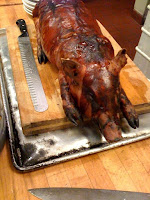
The Philadelphia launch of The Naked Pint, an Unadulterated Guide to Craft Beer (Penguin Group, November 2009) was a great event. In addition to authors Christina Perozzi and Hallie Beaune, Los Angeles Best Beer Sommeliers, the event featured beers from local women in the industry including Suzanne Woods, Sly Fox and the Beer Lass blog; Jodi Stoudt, Stoudt's; Whitney Thompson and Tracy Mulligan (Victory); Wendy Dormant (Dogfish Head), Megan Maguire (Ommegang), Seb Buhler (Rogue). Chef Terence Feury offered great pairings including the Chef's Tapas, Seared Sea Scallops with caramelized brussels sprout leaves, meyer lemon and forchette potatoes with Ommegang Rare Vos, Lightly Smoked Duck Breast with Autumn spiced croutons, dates and root vegetables with Dogfish Head's celebrated Raison d'Etre, and Rich Chocolate Cake with Rogue's Chocolate Stout. Keep apprised of our ongoing series of beer events by signing up for our newsletter!
To keep up with Hallie and Christina, follow their blog: http://www.beerforchicks.com/


























